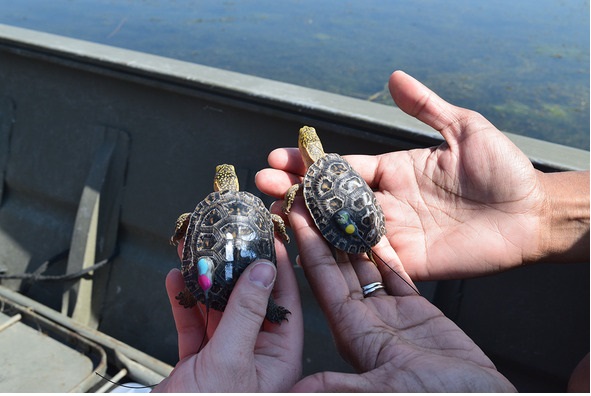Rare Iowa turtles are being tracked with transmitters on their shells
June 12th, 2025 by Ric Hanson
(Radio Iowa) – A few dozen tiny turtles were turned loose in a wetland in Guthrie County this month, the next important step in helping the rare creatures regain numbers in a state where they were once plentiful. Mick Klemesrud, a spokesman for the Iowa DNR, says many populations of Blanding’s turtles died out during a frigid, snowy spring about a decade ago. With the help of Blank Park Zoo in Des Moines, more than 50 were hatched and raised last year.
“We released 32 of them last week. Most of them had a transmitter on them, so we’re going to track their movements and try and get some information on these juveniles, what they do, search for habitat and where they move throughout the wetland,” Klemesrud says, “so we could maybe make some management decisions based on that to help these turtles survive.”
An adult Blanding’s turtle may grow to 10 inches in diameter, resembling an old-style army helmet, but each of these youngsters would fit in the palm of your hand. So how do you track them? Klemesrud says Iowa State University is also a part of this project.

Two of the Blanding’s turtles (Iowa DNR photo)
“They have a student technician that’s going to be going out every day this summer with an aerial transmitter, and she’s going to be tracking these. There’s different frequencies associated with different transmitters,” Klemesrud says. “She’s going to be collecting some of this information just to see, where are they going? What are they using? What is their preferred habitat in the wild?”
Blanding’s turtles are a threatened species in Iowa and they’re being considered for federal listing. Besides the frigid weather, Klemesrud says the turtles face many other challenges in Iowa.
“The turtles will travel a long distance to lay their eggs and so they have to travel across a lot of roads and sometimes they get hit by vehicles. There’s a lot of nest predators that will just completely wipe out their nests,” Klemesrud says. “We have very little natural reproduction. It takes about 14 to 20 years for these turtles to become mature and to start laying eggs, the females, so it just takes a long time to get these back.”
In an agency statement, DNR director Kayla Lyon says: “In the wild, just hatching means these turtles beat the odds. Leaving the nest and finding the wetland is another major achievement, and making it to year one is like winning the lottery — which makes today all the more exciting.”
She says the restoration of wetlands and shallow lakes benefits Blanding’s turtles, in addition to many other wildlife species, including nesting trumpeter swans and sandhill cranes.





